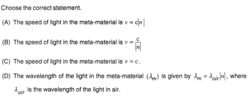Speed of light in material
 Most materials have the refractive index
. So, when a light ray from air enters a naturally occurring material, then by Snell's law,
, it is understood that the refracted ray bends towards the normal. But it never emerges on the same side of the normal as the incident ray.
According to electromagnetism, the refractive index of the medium is given by the relation,
, where
is the speed of electromagnetic waves in vacuum,
its speed in the medium,
and
are the relative permittivity and permeability of the medium respectively.
In normal materials, both
and
are positive, implying positive
for the medium. When both
and
are negative, one must choose the negative root of
. Such negative refractive index materials can now be artificially prepared and are called meta-materials. They exhibit significantly different optical behavior, without violating any physical laws. Since
is negative, it results in a change in the direction of propagation of the refracted light. However, similar to normal materials, the frequency of light remains unchanged upon refraction even in meta-materials. For light incident from air on a meta-material, the appropriate ray diagram is
Most materials have the refractive index
. So, when a light ray from air enters a naturally occurring material, then by Snell's law,
, it is understood that the refracted ray bends towards the normal. But it never emerges on the same side of the normal as the incident ray.
According to electromagnetism, the refractive index of the medium is given by the relation,
, where
is the speed of electromagnetic waves in vacuum,
its speed in the medium,
and
are the relative permittivity and permeability of the medium respectively.
In normal materials, both
and
are positive, implying positive
for the medium. When both
and
are negative, one must choose the negative root of
. Such negative refractive index materials can now be artificially prepared and are called meta-materials. They exhibit significantly different optical behavior, without violating any physical laws. Since
is negative, it results in a change in the direction of propagation of the refracted light. However, similar to normal materials, the frequency of light remains unchanged upon refraction even in meta-materials. For light incident from air on a meta-material, the appropriate ray diagram is
This section requires Javascript.
You are seeing this because something didn't load right. We suggest you, (a) try
refreshing the page, (b) enabling javascript if it is disabled on your browser and,
finally, (c)
loading the
non-javascript version of this page
. We're sorry about the hassle.
The speed of light in a medium other than vacuum (or even air, in some cases) is always lower. The refractive index simply tells one about the extent by which light slows down. If the refractive index of a material is 1.5, light would slow down by a factor of 1.5 when going through that material. It's a result of Snell's Law of Refraction, where;
Sin I/Sin R=n and, n=c/v :D